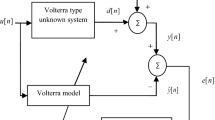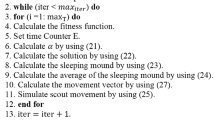Abstract
This paper presents the handling of nonlinear system identification problem based on Volterra-type nonlinear systems. An efficient arithmetic optimization algorithm (AOA) along with the Kalman filter (KF) is being used for the estimation/identification purpose. The KF is proved to be a good state estimator in estimation theory. It is used to estimate the unknown variables with some given measurements observed over time. However, the performance of KF technique degrades while dealing with real-time state estimation problems. To overcome the problem encountered in KF technique, two steps are followed for nonlinear system identification. The first one involves evaluation of the KF parameters using the AOA algorithm by taking a considerable fitness function. The second step is to estimate the parameters of Volterra model using the KF method utilizing the optimal KF parameters attained in first step. In order to prove the efficiency of the proposed KF assisted AOA algorithm is further tested on various benchmark unknown Volterra models. Simulated results are reported in terms of mean square error (MSE), mean square deviation (MSD), Volterra coefficients estimation error, and fitness percentage. The results are compared with other similar algorithms such as sine cosine algorithm (SCA) assisted KF (SCA-KF), cuckoo search algorithm (CSA) assisted KF (CSA-KF), particle swarm optimization (PSO) assisted KF (PSO-KF) and genetic algorithm (GA) assisted KF (GA-KF). The reported results reveal that AOA-KF algorithm is the right choice for nonlinear system identification problem compared to the SCA-KF, CSA-KF, PSO-KF and GA-KF.










Similar content being viewed by others
References
Abualigah L, Diabat A, Mirjalili S, Abd Elaziz M, Gandomi AH (2021) The arithmetic optimization algorithm. Comput Methods Appl Mech Eng 376:113609
Al-Duwaish HN (2011) Identification of Hammerstein models with known nonlinearity structure using particle swarm optimization. Arab J Sci Eng 36(7):1269–1276
Angelov P (1994) A generalized approach to fuzzy optimization. Int J Intell Syst 9(3):261–268
Angelov PP, Gu X (2019) Empirical approach to machine learning. Springer, London
Angelov PP, Gu X, Príncipe JC (2017) A generalized methodology for data analysis. IEEE Trans Cybern 48(10):2981–2993
de Assis LS, Junior JRdP, Tarrataca L, Haddad DB (2019) Efficient Volterra systems identification using hierarchical genetic algorithms. Appl Soft Comput 85:105745
Batselier K, Chen Z, Wong N (2017) A tensor network Kalman filter with an application in recursive mimo Volterra system identification. Automatica 84:17–25
Batselier K, Wong N (2018) Matrix output extension of the tensor network Kalman filter with an application in MIMO Volterra system identification. Automatica 95:413–418
Beldjilali B, Benadda B, Sadouni Z (2020) Vehicles circuits optimization by combining gps/gsm information with metaheuristic algorithms. Romanian J Inform Sci Technol 23T:T5–T17
Biagiola SI, Figueroa JL (2009) Wiener and Hammerstein uncertain models identification. Math Comput Simul 79(11):3296–3313
Bittanti S, Piroddi L (1997) Nonlinear identification and control of a heat exchanger: a neural network approach. J Franklin Inst 334(1):135–153
Brown RG, Hwang PY (1997) Introduction to random signals and applied Kalman filtering: with matlab exercises and solutions. Introduction to random signals and applied Kalman filtering: with MATLAB exercises and solutions
Chang Wei-Der (2012) Volterra filter modeling of nonlinear discrete-time system using improved particle swarm optimization. Dig Signal Process 22(6):1056–1062
Cuevas E, Díaz P, Avalos O, Zaldívar D, Pérez-Cisneros M (2018) Nonlinear system identification based on ANFIS-Hammerstein model using gravitational search algorithm. Appl Intell 48(1):182–203
Durmuş B (2021) Infinite impulse response system identification using average differential evolution algorithm with local search. Neural Comput Appl 34:1–16
Ebrahimi SM, Malekzadeh M, Alizadeh M, HosseinNia SH (2021) Parameter identification of nonlinear system using an improved Lozi map based chaotic optimization algorithm (ilcoa). Evol Syst 12(2):255–272
Ekşioğlu EM, Kayran AH (2005) Volterra kernel estimation for nonlinear communication channels using deterministic sequences. AEU-Int J Electron Commun 59(2):118–127
Garcia R, Pardal P, Kuga H, Zanardi M (2019) Nonlinear filtering for sequential spacecraft attitude estimation with real data: Cubature Kalman filter, unscented Kalman filter and extended Kalman filter. Adv Space Res 63(2):1038–1050
Gu X, Angelov P, Rong HJ (2019) Local optimality of self-organizing neuro-fuzzy inference systems. Inf Sci 503:351–380
Gu X, Shen Q, Angelov PP (2020) Particle swarm optimized autonomous learning fuzzy system. IEEE Trans Cybern 51(11):5352–5363
Havangi R (2018) Joint parameter and state estimation based on marginal particle filter and particle swarm optimization. Circuits Syst Signal Process 37(8):3558–3575
Jaleel EA, Aparna K (2019) Identification of realistic distillation column using hybrid particle swarm optimization and narx based artificial neural network. Evol Syst 10(2):149–166
Janjanam L, Saha SK, Kar R, Mandal D (2021) Global gravitational search algorithm-aided Kalman filter design for Volterra-based nonlinear system identification. Circuits Syst Signal Process 40(5):2302–2334
Janjanam L, Saha SK, Kar R, Mandal D (2021) An efficient identification approach for highly complex non-linear systems using the evolutionary computing method based Kalman filter. AEU-Int J Electron Commun 138:153890
Janjanam L, Saha S, Kar R, Mandal D (2020) Volterra filter modelling of non-linear system using Artificial Electric Field algorithm assisted Kalman filter and its experimental evaluation. ISA Trans
Jiang S, Wang Y, Ji Z (2015) A new design method for adaptive IIR system identification using hybrid particle swarm optimization and gravitational search algorithm. Nonlinear Dyn 79(4):2553–2576
Kim T, Adhikaree A, Pandey R, Kang DW, Kim M, Oh CY, Baek JW (2018) An on-board model-based condition monitoring for lithium-ion batteries. IEEE Trans Ind Appl 55(2):1835–1843
Koukoulas P, Kalouptsidis N (2000) Second-order Volterra system identification. IEEE Trans Signal Process 48(12):3574–3577
Kumar M, Aggarwal A, Rawat T, Parthasarathy H (2016) Optimal nonlinear system identification using fractional delay second-order Volterra system. IEEE/CAA J Autom Sin. https://doi.org/10.1109/jas.2016.7510184
Li X, Chen L, Tang Y (2020) Hard: Bit-split string matching using a heuristic algorithm to reduce memory demand. Romanian J Inform Sci Technol 23:T94–T105
Lu L, Zhao H (2016) Adaptive Volterra filter with continuous lp-norm using a logarithmic cost for nonlinear active noise control. J Sound Vib 364:14–29
Lu L, Zhao H, Chen B (2016) Improved-variable-forgetting-factor recursive algorithm based on the logarithmic cost for Volterra system identification. IEEE Trans Circuits Syst II Express Briefs 63(6):588–592
Manolakis DG, Ingle VK, Kogon SM et al (2000) Statistical and adaptive signal processing: spectral estimation, signal modeling, adaptive filtering, and array processing. McGraw-Hill, Boston
Mauroy A, Goncalves J (2019) Koopman-based lifting techniques for nonlinear systems identification. IEEE Trans Autom Control 65(6):2550–2565
Mazaheri A, Mansouri M, Shooredeli M (2014) 2014 Second RSI/ISM International Conference on Robotics and Mechatronics (ICRoM) (IEEE), pp 298–303
Mehra R (1972) Approaches to adaptive filtering. IEEE Trans Autom Control 17(5):693–698
Mete S, Ozer S, Zorlu H (2016) System identification using Hammerstein model optimized with differential evolution algorithm. AEU-Int J Electron Commun 70(12):1667–1675
Mohammadi A, Zahiri SH, Razavi SM (2018) Infinite impulse response systems modeling by artificial intelligent optimization methods. Evol Syst 10:1–17
De Moor B, De Gersem P, De Schutter B, Favoreel W (1997) Daisy: a database for identification of systems. Journal A 38:4–5
Pakrashi A, Chaudhuri BB (2016) A Kalman filtering induced heuristic optimization based partitional data clustering. Inf Sci 369:704–717
Pozna C, Precup RE, Horvath E, Petriu EM (2022) Hybrid particle filter-particle swarm optimization algorithm and application to fuzzy controlled servo systems. IEEE Trans Fuzzy Syst
Precup RE, David RC (2019) Nature-inspired optimization algorithms for fuzzy controlled servo systems. Butterworth-Heinemann, Oxford
Rashedi E, Nezamabadi-Pour H, Saryazdi S (2011) Filter modeling using gravitational search algorithm. Eng Appl Artif Intell 24(1):117–122
Saha S, Kar R, Mandal D, Ghoshal S (2015) Optimal IIR filter design using gravitational search algorithm with wavelet mutation. J King Saud Univ Comput Inform Sci 27(1):25–39
Saigaa M, Chitroub S, Meraoumia A (2021) An effective biometric identification system using enhanced palm texture features. Evol Syst 13:1–21
Schumacher R, Lima EG, Oliveira GH (2016) RF power amplifier behavioral modeling based on Takenaka–Malmquist–Volterra series. Circuits Syst Signal Process 35(7):2298–2316
Shaikh MAH, Barbé K (2019) Wiener-Hammerstein system identification: a fast approach through spearman correlation. IEEE Trans Instrum Meas 68(5):1628–1636
da Silva FB, Martins WA (2019) Semi-blind data-selective and multiple threshold Volterra adaptive filtering. Circuits Syst Signal Process 39:1–24
Simon D (2006) Optimal state estimation: Kalman, H infinity, and nonlinear approaches. Wiley, London
Singh S, Ashok A, Kumar M, Rawat TK (2019) Adaptive infinite impulse response system identification using teacher learner based optimization algorithm. Appl Intell 49(5):1785–1802
Sliwiński P, Marconato A, Wachel P, Birpoutsoukis G (2017) Non-linear system modelling based on constrained Volterra series estimates. IET Control Theory Appl 11(15):2623–2629
Söderström T, Stoica P (1989) System identification. Prentice-Hall, Hoboken
Walpole RE, Myers RH, Myers SL, Ye K (1993) Probability and statistics for engineers and scientists, vol 5. Macmillan, New York
Wang SY, Yin C, Duan SK, Wang LD (2017) A modified variational Bayesian noise adaptive Kalman filter. Circuits Syst Signal Process 36(10):4260–4277
Wolpert DH, Macready WG (1997) No free lunch theorems for optimization. IEEE Trans Evol Comput 1(1):67–82
Xu W, Wang S, Fernandez C, Yu C, Fan Y, Cao W (2020) Novel reduced-order modeling method combined with three-particle nonlinear transform unscented Kalman filtering for the battery state-of-charge estimation. J Power Electron 20(6):1541–1549
Xu D, Wu Z, Huang Y (2019) A new adaptive Kalman filter with inaccurate noise statistics. Circuits Syst Signal Process 38(9):4380–4404
Xu W, Xu J, Yan X (2020) Lithium-ion battery state of charge and parameters joint estimation using cubature Kalman filter and particle filter. J Power Electron 20(1):292–307
Yadav Suman, Yadav Richa, Kumar Ashwni, Kumar Manjeet (2021) A novel approach for optimal design of digital FIR filter using grasshopper optimization algorithm. ISA Trans 108:196–206
Yazid E, Liew MS, Parman S, Kurian VJ (2015) Improving the modeling capacity of Volterra model using evolutionary computing methods based on Kalman smoother adaptive filter. Appl Soft Comput 35:695–707
Yin KL, Pu YF, Lu L (2020) Combination of fractional FLANN filters for solving the Van der Pol-Duffing oscillator. Neurocomputing 399:183–192
Yu F, Mao Z, Yuan P, He D, Jia M (2017) Recursive parameter estimation for Hammerstein-Wiener systems using modified ekf algorithm. ISA Trans 70:104–115
Zamfirache IA, Precup RE, Roman RC, Petriu EM (2022) Reinforcement learning-based control using q-learning and gravitational search algorithm with experimental validation on a nonlinear servo system. Inf Sci 583:99–120
Zhou X, Yang C, Gui W (2014) Nonlinear system identification and control using state transition algorithm. Appl Math Comput 226:169–179
Zhou H, Zhao H, Zhang Y (2020) Nonlinear system modeling using self-organizing fuzzy neural networks for industrial applications. Appl Intell 50:1–16
Author information
Authors and Affiliations
Author notes
Alaknanda Ashok and Tarun Kumar Rawat have contributed equally to this work.
Contributions
All the three authors have contributed equally in this work.
Corresponding author
Ethics declarations
Conflict of interest
The authors declare that they have no conflict of interest.
Additional information
Publisher's Note
Springer Nature remains neutral with regard to jurisdictional claims in published maps and institutional affiliations.
Rights and permissions
About this article
Cite this article
Singh, S., Ashok, A. & Rawat, T.K. Optimal Volterra-based nonlinear system identification using arithmetic optimization algorithm assisted with Kalman filter. Evolving Systems 14, 117–139 (2023). https://doi.org/10.1007/s12530-022-09439-z
Received:
Accepted:
Published:
Issue Date:
DOI: https://doi.org/10.1007/s12530-022-09439-z




